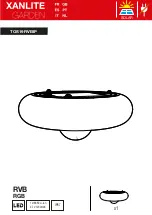
8
PREPARATION
Preparing for take-off
As for any aircraft a thorough pre-flight check must be made prior to each flight on the
Aravis! Before every launch check lines, risers and canopy for damage! Do not launch with
even the slightest damage!
Also check the quick links connecting the lines and the risers. They have to be closed tight.
Put on the harness with maximum care and check the handle of the safety system and that
all the flaps of the outer container are fastened securely and correctly. The main karabiner
must also be checked carefully. Replace it if any damage is visible, or generally after
300 flying hours. Finally connect the risers to your harness with the main karabiners.
Check carefully that they are properly closed. Attention! Never fly with an open main
karabiner! Do not take off if you find any damage on your equipment!
Harness
For flight comfort and safety it is very important that you fly with a suitable, properly
adjusted harness. It is important to set up your harness correctly before flying the glider.
Make sure to spend time adjusting your harness’s different settings until your sitting
position is completely comfortable. The Aravis is certified for use with all harnesses with
variable cross-bracing (GH type). Practically all modern harnesses are GH type harnesses.
Older harnesses with fixed cross-bracing (GX type) are not certified and should not be
used.
It’s important for your comfort and safety to fly with a suitable harness that is properly
adjusted. When choosing a harness, remember that the height of the attachment points
(i.e. distance from the carabiners to the seat plate) affects the sensitivity of the glider and
the relative brake travel. The lower position of the carabiners, the more sensitive the glider
is to weight-shift.
The adjustment of the chest strap change the distance between carabiners and affects the
stability of the glider and its handling. Excessive tightening of the chest strap increases
stability but also the risk of riser twists following glider collapses. It also increases the
tendency of getting collapses due to poor feedback from the glider. The risk of twisting is
also strongly influenced by the seating position of the pilot. Flying in a laid back (reclined)
position makes it much more difficult to react in time to prevent riser twisting. With the
chest strap in a more closed position the glider also has more tendency to maintain a
stable spiral. With the chest strap in a more open position, feedback from the glider
increase but stability decrease.
EN certification test flights are carried out with the horizontal distance between the harness
attachments points (measured between connector centrelines) set depending on the total
weight in flight as follows:
Total weight in flight
<80 kg 80 to 100 kg
> 100 kg
Width 40 ± 2 cm
44 ± 2 cm
48 ± 2 cm
Содержание ARAVIS 17
Страница 1: ...1 ...
Страница 31: ...31 LINE PLAN ARAVIS ...
Страница 34: ...34 CHECKS Name Company Date Signature Stamp ...
Страница 36: ...36 ...









































